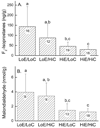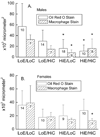Combined vitamin C and vitamin E deficiency worsens early atherosclerosis in apolipoprotein E-deficient mice
- PMID: 20558818
- PMCID: PMC2924448
- DOI: 10.1161/ATVBAHA.110.209502
Combined vitamin C and vitamin E deficiency worsens early atherosclerosis in apolipoprotein E-deficient mice
Abstract
Objective: To assess the role of combined deficiencies of vitamins C and E on the earliest stages of atherosclerosis (an inflammatory condition associated with oxidative stress), 4 combinations of vitamin supplementation (low C/low E, low C/high E, high C/low E, and high C/high E) were studied in atherosclerosis-prone apolipoprotein E-deficient mice also unable to synthesize their own vitamin C (gulonolactone oxidase(-/-)); and to evaluate the effect of a more severe depletion of vitamin C alone in a second experiment using gulonolactone oxidase(-/-) mice carrying the hemizygous deletion of SVCT2 (the vitamin C transporter).
Methods and results: After 8 weeks of a high-fat diet (16% lard and 0.2% cholesterol), atherosclerosis developed in the aortic sinus areas of mice in all diet groups. Each vitamin-deficient diet significantly decreased liver and brain contents of the corresponding vitamin. Combined deficiency of both vitamins increased lipid peroxidation, doubled plaque size, and increased plaque macrophage content by 2- to 3-fold in male mice, although only plaque macrophage content was increased in female mice. A more severe deficiency of vitamin C in gulonolactone oxidase(-/-) mice with defective cellular uptake of vitamin C increased both oxidative stress and atherosclerosis in apolipoprotein E(-/-) mice compared with littermates receiving a diet replete in vitamin C, again most clearly in males.
Conclusions: Combined deficiencies of vitamins E and C are required to worsen early atherosclerosis in an apolipoprotein E-deficient mouse model. However, a more severe cellular deficiency of vitamin C alone promotes atherosclerosis when vitamin E is replete.
Figures



Similar articles
-
Vulnerable atherosclerotic plaque morphology in apolipoprotein E-deficient mice unable to make ascorbic Acid.Circulation. 2002 Mar 26;105(12):1485-90. doi: 10.1161/01.cir.0000012142.69612.25. Circulation. 2002. PMID: 11914259
-
Selective macrophage ascorbate deficiency suppresses early atherosclerosis.Free Radic Biol Med. 2011 Jan 1;50(1):27-36. doi: 10.1016/j.freeradbiomed.2010.10.702. Epub 2010 Oct 23. Free Radic Biol Med. 2011. PMID: 20974251 Free PMC article.
-
Combined vitamin C and E deficiency induces motor defects in gulo(-/-)/SVCT2(+/-) mice.Nutr Neurosci. 2013 Jul;16(4):160-73. doi: 10.1179/1476830512Y.0000000042. Epub 2012 Dec 4. Nutr Neurosci. 2013. PMID: 23321552 Free PMC article.
-
Plasmacytoid dendritic cells play a key role in promoting atherosclerosis in apolipoprotein E-deficient mice.Arterioscler Thromb Vasc Biol. 2012 Nov;32(11):2569-79. doi: 10.1161/ATVBAHA.112.251314. Epub 2012 Aug 30. Arterioscler Thromb Vasc Biol. 2012. PMID: 22936340
-
Poly(ADP-ribose) polymerase inhibition reduces atherosclerotic plaque size and promotes factors of plaque stability in apolipoprotein E-deficient mice: effects on macrophage recruitment, nuclear factor-kappaB nuclear translocation, and foam cell death.Circulation. 2007 May 8;115(18):2442-50. doi: 10.1161/CIRCULATIONAHA.106.668756. Epub 2007 Apr 16. Circulation. 2007. PMID: 17438151
Cited by
-
Benzo[a]pyrene potentiates the pathogenesis of abdominal aortic aneurysms in apolipoprotein E knockout mice.Cell Physiol Biochem. 2012;29(1-2):121-30. doi: 10.1159/000337593. Epub 2012 Mar 1. Cell Physiol Biochem. 2012. PMID: 22415081 Free PMC article.
-
Influence of Vitamins on Secondary Reactive Oxygen Species Production in Sera of Patients with Resectable NSCLC.Diseases. 2016 Jul 14;4(3):25. doi: 10.3390/diseases4030025. Diseases. 2016. PMID: 28933405 Free PMC article.
-
Antioxidants in the Fight Against Atherosclerosis: Is This a Dead End?Curr Atheroscler Rep. 2018 May 21;20(7):36. doi: 10.1007/s11883-018-0737-7. Curr Atheroscler Rep. 2018. PMID: 29781062 Free PMC article. Review.
-
Cytomegalovirus infection of the fetal brain: intake of aspirin during pregnancy blunts neurodevelopmental pathogenesis in the offspring.J Neuroinflammation. 2024 Nov 15;21(1):298. doi: 10.1186/s12974-024-03276-4. J Neuroinflammation. 2024. PMID: 39548550 Free PMC article.
-
Ascorbic acid and the brain: rationale for the use against cognitive decline.Nutrients. 2014 Apr 24;6(4):1752-81. doi: 10.3390/nu6041752. Nutrients. 2014. PMID: 24763117 Free PMC article. Review.
References
-
- Ross R. Atherosclerosis--an inflammatory disease. N. Engl. J. Med. 1999;340:115–126. - PubMed
-
- Cook NR, Albert CM, Gaziano JM, Zaharris E, MacFadyen J, Danielson E, Buring JE, Manson JE. A randomized factorial trial of vitamins C and E and beta carotene in the secondary prevention of cardiovascular events in women: results from the Women's Antioxidant Cardiovascular Study. Arch. Intern. Med. 2007;167:1610–1618. - PMC - PubMed
-
- Heart Protection Study Collaborative Group. MRC/BHF Heart Protection Study of antioxidant vitamin supplementation in 20,536 high-risk individuals: a randomised placebo-controlled trial. Lancet. 2002;360:23–33. - PubMed
Publication types
MeSH terms
Substances
Grants and funding
- HL065709/HL/NHLBI NIH HHS/United States
- HL065405/HL/NHLBI NIH HHS/United States
- P50 GM015431/GM/NIGMS NIH HHS/United States
- R01 HL057986/HL/NHLBI NIH HHS/United States
- R01 HL065709/HL/NHLBI NIH HHS/United States
- U24 DK059637/DK/NIDDK NIH HHS/United States
- GM15431/GM/NIGMS NIH HHS/United States
- R01 HL086988/HL/NHLBI NIH HHS/United States
- R01 DK050435/DK/NIDDK NIH HHS/United States
- HL086988/HL/NHLBI NIH HHS/United States
- DK020593/DK/NIDDK NIH HHS/United States
- P01 GM015431/GM/NIGMS NIH HHS/United States
- R01 HL065405/HL/NHLBI NIH HHS/United States
- DK59637/DK/NIDDK NIH HHS/United States
- P30 DK020593/DK/NIDDK NIH HHS/United States
- DK050435/DK/NIDDK NIH HHS/United States
- HL057986/HL/NHLBI NIH HHS/United States
LinkOut - more resources
Full Text Sources
Medical
Molecular Biology Databases

